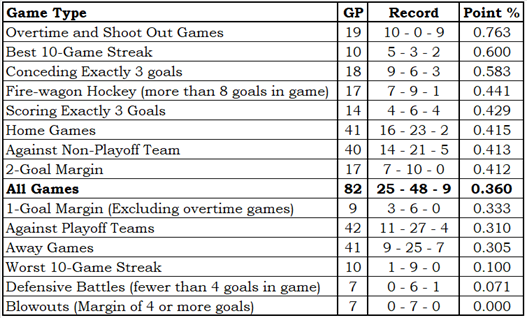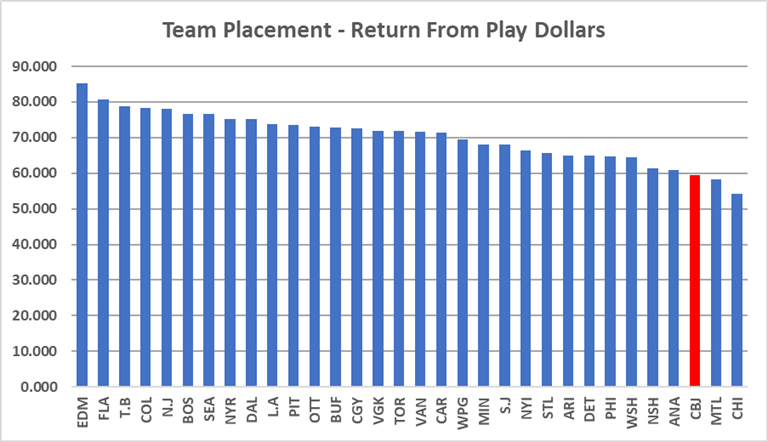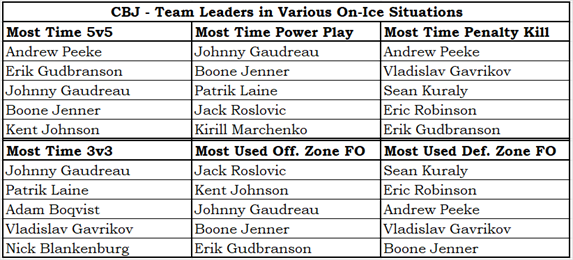Standings

Team Record by Game Type

Talent Distribution

Return From Play

Lines and Pairs


Team Leaders – Stapled To The Bench Categories

Team Leaders – On-Ice Situations

Team Essay – Johnny Hockey
Johnny Gaudreau (aka Johnny Hockey) moved from Calgary to Columbus before the start of the 2022-23 season. In Calgary, Gaudreau had a plus/minus of +66 (at even strength) and 115 points. As a team, Columbus had a plus/minus of -30 and were outscored by Calgary 258 to 291.
Things in Columbus were supposed to change, and they did. They scored 213 goals on the season (down 45), and their even strength plus/minus nose-dived to -94. This was not the desired change.
Gaudreau looks to be the main culprit for the drop in scoring, as that is why he was brought to town. It would be unfair to blame Gaudreau for the team’s defensive woes, as he doesn’t play defensively. For proof, I give you his standing in the Disruption Index from 2022-23: of 436 players who were evaluated, he was just outside the top ten at 413th.
Did Gaudreau have a bad season? I would argue that he had a normal season.
In the STTB article A Player’s First Year on a New Team, I showed that players coming off good (for them) seasons tended to have a poorer subsequent season. It happened 75% of the time. Let’s see Gaudreau’s Career Productivity Rating chart to see if he follows that pattern.

The definition of a player having a good-for-them season is that his PR-Score was higher than his VR-Score. VR-Score is a weighted three-season average, and the first season he qualified for a VR-Score was 2015-16. Gaudreau has had four good seasons, easily identifiable on the career PR chart: 2015-16, 2017-18, 2018-19 and 2021-22. His follow-up to three of those seasons was a drop in PR, with 2018 being the only season in which he had good seasons back-to-back.
Far from being a bad season for Gaudreau, 2022-23 was basically the third-best season of his career. It was worse than his 2021-22 and 2018-19 seasons, but it was essentially the same as his 2015-16 and 2017-2018 seasons. His VR-Score in 2022-23 went up.

The woeful season that Columbus had in 2022-23 cannot be blamed on Gaurdreau. Of their projected top six forwards (from LastWordOnSports.com), Gustav Nyquist and Jakub Voracek both suffered season-ending injuries. Interestingly, neither is still a Blue Jacket.
Turning to the projected top four defensemen, Zach Werenski had a season-ending injury and played fewer than fifteen games, Andrew Peeke had an okay season, Vladislav Gavrikov was traded (and was having a back-to-normal season after having had a good-for-him season), and Erik Gudbranson had a just-above-average-for-him season.
Looking between the pipes, Blue Jacket goalies conceded 40 goals more than expected (329 goals against, 288.1 expected goals against). I would place the responsibility for the +40 goals against on the goalies; the team in front of them was responsible for the 288 expected goals against.
Columbus’s poor season was, in large part, caused by 30% of their top-ten players being injured in the early part of the season. Please do not confuse this statement with me saying that the poor season was the fault of these players. It would only be their fault if they got injured on purpose, and nobody gets a concussion or tears a labrum on purpose.
As a result of the injuries, lesser players were forced into bigger roles, and they weren’t able to ramp up their skill set to those levels.
And perhaps the bigger problem for Columbus was obvious in pre-season, before a single game was played: Erik Gudbranson was projected as one of their top four defensemen. On middle-of-the-pack teams, he’s a fifth or sixth defenseman. On better teams, he’d spend the season figuring out his favourite seat in the press box. He is not a top-four defenseman. That Gudbranson was given a role that was above his skill set is not his fault.
As you might infer from the last three paragraphs, I’m not big on assigning blame to people. Blaming people is not productive and it is usually inaccurate. Players got injured and it wasn’t their fault. Gudbranson played like Gudbranson plays, and that isn’t his fault. The goalies gave up 40 more goals than they should have, and that … well, that might be their fault. Or they might just have had below-average seasons: that happens too.
